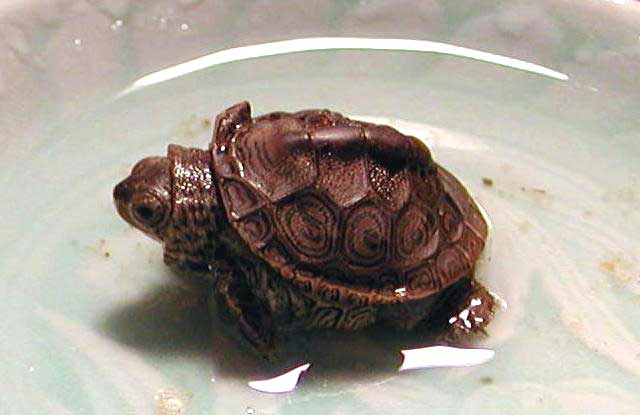 Looking quite different from their cold-stunned appearance on the beach, the turtles proved in fine form. A Kempís ridley rescued on the afternoon of 16 December (see A Blizzard of Sea Turtles) in 39°F water temperature showed how much she had improved. It really is hard to believe that these turtles are the same species we pull from the beach.
Meanwhile, back in the Land of Ooze, harp seal pups began to arrive by the dozens, lounging on beaches and hiding in hurricane holes to catch a breather from the storms. Most are quite healthy, if a bit tired, and need to seclusion the Cape offers in winter to recharge their batteries. Some, though, need a bit more attention. But not this character whom I discovered resting on Lieutenant Islandís plover point. |

|
And this last week we witnessed our most serious mammal stranding of the year. A pod of white-sided dolphins followed bait fish deep into Wellfleet Harbor to its northwest corner, just as the tide dropped precipitously beneath them. First three dolphins stranded in the tidal flats near the Herring River dike, while a dozen more were trapped at the riverís mouth. A construction team, working on a cottage overlooking the harbor, raced down the bluff, stripped off their heavy boots, and waded into the icy water to save these magnificent 400 pound mammals. With raw hands turned pink then white in the cold, they splashed water on the dolphins for over an hour until the Stranding Network arrived on the scene. Even then, they refused to leave until forced off the flats by the returning flood tide. |
|
 At least seven of the animals were freed and released into deeper water and a few more stranded throughout the bay got away as the tide gushed back in. As usual, the whole community responded. From shellfish constables to construction workers, all pitched in to work side-by-side with the rescue professionals of the Cape Cod Mammal Stranding Network. |
|
On the domestic turtle front, Bubbles has become demanding while waiting for her springtime release. She seems completely healed from the punctured carapace and cracked bridge (see Holiday Guests ó 13 December 2001) she suffered in mid October. In fact, she insisted
Finally, the over-wintering hatchling exposed by storms in January (see Expecting the Unexpected ó 18 January 2002) has adopted a regular behavior pattern while she waits out winter. She burrows under the sand in her faux paludal tank for about a week, then slips out on a bright shiny morning, strolls around the aquarium to flex her muscles, then soaks in her fake pond to rehydrate. Later in the day she searches the tank for the perfect spot and spirals back down under the sand for another week-long nap. |
